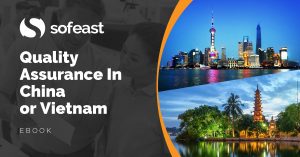I see some good advice, published in Linkedin or elsewhere, aimed at importers sourcing products from China, Vietnam, or other low-cost Asian countries.
A lot of this advice is sound. However, I noticed that a good chunk is NOT applicable to companies buying under 20 million USD a year — and, sometimes, not under 1 billion USD a year.
I made a list of 9 things large importers can get, but small companies usually can’t negotiate. (Of course, there are many exceptions, but they remain marginal if only 5% of small importers can get away with them.)
1. Negotiate with large contract manufacturers in many countries
Apple has recently been studying whether to produce some iPhones in Vietnam or in India. They know that large contract manufacturers (e.g. Foxconn) are willing to set up a plant wherever Apple wants.
Now, try and source batches of 5,000 mobile phones in Vietnam or India, and compare that to sourcing them from mainland China… At this size, buying outside of China is more difficult, slower, and probably more pricey.
2. Reserve production capacity for the mid- or even the long-term
This is also related to working with a large contract manufacturer (CM). For example, 5 years ago, I was told that VF Corp. had reserved the capacity of several buildings in Chittagong (Bangladesh). They were working with a Korean CM.
Large companies with mature planning and distribution systems have an idea about their needs 5 years into the future, and they can work with companies that are happy to work based on ‘light’ commitments.
3. Negotiate directly with large sub-suppliers
Li & Fung reserves greige fabric and dyeing capacity before they know the colors their customers’ designers will choose. This is made possible by concentrating a large buying power and talking directly with large sub-suppliers.
Similarly, Apple reserves thousands of tons of certain materials, and they are ready to pay a premium if it is hard to procure. If, for example, they need nylon 6/6, other industries that need that same plastic will only be able to share the remainders…
4. Open-book visibility about the manufacturing facility
Can you dream of knowing what your supplier pays for rent, per employee, for each line on the bill of materials, and so on?
For large buyers such as General Motors or Airbus, this is a given. Any part supplier not willing to share this level of detail is discarded.
5. Force the factory to use your own ERP system
In the auto industry, many tier-one suppliers have to use SAP. And not just their own SAP implementation… the auto maker’s instance of SAP (so that it integrates perfectly with the rest of their database). No discussion.
So, if 50% of a plant’s activity is for GM, 40% is for Chrysler, and the rest is for smaller customers, the plant will need to use 3 different ERP instances.
What about the typical small buyer? They usually work with factories making than 10 million USD in sales… and using no ERP for the core of their activity (material planning, production planning, etc.).
6. ‘Open account’ payment terms
This is also much more common for large companies. Many suppliers want to work with them, so they can impose their terms. (On the other hand, I should mention that finding a financial institution for vendor financing is often easier.)
7. Product warranty & liability from the supplier
The manufacturer is obliged by legally-enforceable contracts to bear product warranty and liability obligations. They are also often forced to carry liability insurance, for cases where liability is so high it can’t be covered by the supplier.
This is pretty much unheard of for an importer buying ‘only’ 500,000 USD a year from a given factory…
8. Shaping the supply chain PHYSICALLY
You set up a mammoth plant and you don’t want your high-value component suppliers to be more than 1 hour away from you, for just-in-time inventory replenishment? They can be requested to set up a new manufacturing facility next to you.
9. Have their own teams on site all the time
When you develop new products, can you afford to have your own engineers at the main factory, and going around component factories as well? Probably not with the same intensity as, say Apple (who dispatch not only engineers but also supply chain security staff and so on and so forth).
In the end, that makes a very large difference in quality & time-to-market performance.
—
Any other advice that large buyers can apply but most small/midsize importers have trouble following?
Sofeast: Quality Assurance In China Or Vietnam For Beginners [eBook]
This free eBook shows importers who are new to outsourcing production to China or Vietnam the five key foundations of a proven Quality Assurance strategy, and also shows you some common traps that importers fall into and how to avoid or overcome them in order to get the best possible production results.
Ready to get your copy? Hit the button below:


